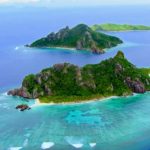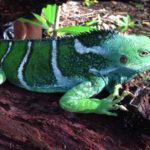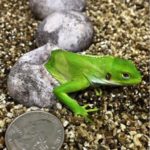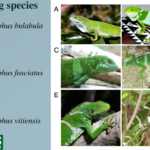Joey leaves Oklahoma for 6 months in Fiji
-
After training with the United States Geological Survey (USGS) in San Diego for the next month, I will depart on a six-month research expedition in Fiji that will focus on the ecology and conservation of the critically endangered Fijian crested iguana (Brachylophus vitiensis). Working on a large collaborative project supported by San Diego Zoo Global, USGS, International Iguana Foundation, and the National Trust of Fiji, we will be using radio telemetry (via tiny VHF transmitters attached to the body) for an in-depth study of iguana behavior and spatial ecology. By tracking the movements and interactions between iguanas, this study will help us figure out the iguana’s dispersal patterns, preferred habitats, nesting behaviors, and population viability in fragmented and disturbed forests throughout Fiji.
Several of the world’s 44 species of iguanas make up some of the most threatened vertebrates around the world. The South Pacific iguanas of the genus Brachylophus represent a highly endangered localized group of three living species native to the Fiji Islands— (1) Central Fijian Banded Iguana (B. bulabula), (2) Lau Banded Iguana (B. fasciatus), and (3) the Fijian Crested Iguana (B. vitiensis).
This project specifically focuses on the Fijian crested iguanas found on the island of Monuriki—a 40 hectare (100 acre) uninhabited island off the west coast of Fiji. With less than 100 individuals remaining in the wild, the Monuriki Island iguana population is the most threatened iguana species in Fiji and it has been determined to be of high risk of extinction due to its genetic and morphological uniqueness.
These iguanas are highly arboreal, herbivorous lizards that face threats due to habitat destruction from humans, predation from non-native introduced feral cats, rats, and mongoose, and forest degradation from introduced goats (i.e. over grazing of dry forest habitat). In 2012, thanks to support and community engagement from local Fijians, all goats were eradicated from Monuriki and the dry forest habitat essential for iguana survival has now had over five years for restoration and regrowth. At the same time of goat eradication in 2012, several wild iguanas were placed in captivity at Kula Eco Park as part of the species recovery plan to initiate a captive assurance colony and head-start program through captive breeding efforts.
Now, in an attempt to repopulate crested iguana populations, we will be releasing wild-caught and captive-bred iguanas back into the wild and tracking their movements through radio telemetry. By developing a monitoring program for wild and reintroduced (aka head-started) iguanas, this project will not only help save this species from extinction, but it will enable baseline data collection to help gauge head-starting as an effective conservation tool within Fiji for all Brachylophus iguanas.
Understanding the natural movements and behaviors of wild animals is essential for successful population management. Radio telemetry provides the tool for obtaining this critical information and will help us track the success and health of the animals post release. In addition to tracking captive bred iguanas, this study will provide the first ever opportunity to track completely wild Brachylophus. Survivorship and behavior comparisons will be conducted between the captive-bred iguanas and the wild-caught release groups. This vital information will help better guide recovery efforts for all iguana species within Fiji and will be implemented as part of the ongoing species recovery plan for future populations.
In the end, this project will help ensure the survival and successful management of a critically endangered population of Fijian crested iguanas (Brachylophus vitiensis), and provide valuable information for all threatened iguana species around the world.
Update: The Fiji Times has just published an article highlighting the progress to-date on this research. (3/3/17)




